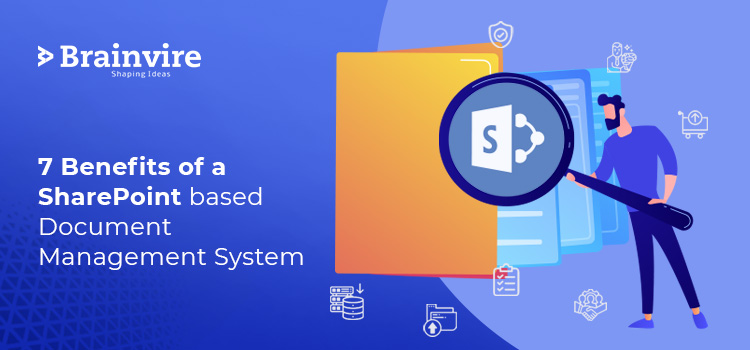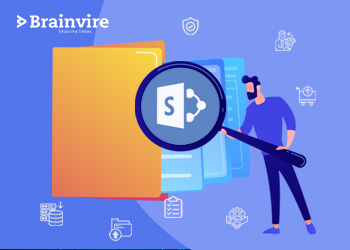
Documents are an important component of just about every organization, whether electronic or paper. It can be a difficult task to handle business knowledge, often from many sources. A document management system (DMS) that collects, stores, and retrieves both paper and electronic documents can give your organization several key benefits, depending on the nature of your enterprise.
Enterprise document management, being time-consuming and vulnerable to human error, is typically among the processes that companies want to automate first. As a result, from year to year, investment in applications for document management continues to increase.
Because of the 2020 lockdown, the global acceptance of remote workflows has driven organizations to be even more involved in adopting digital document management solutions. The document management systems market will rise from $4.89 billion in 2019 to $10.17 billion by 2025, according to ReportLinker’s Document Management Systems Market — Growth, Developments, Projections (2020 – 2025).
7 Problems Solved by a DMS
1. Reduced Storage Space
Commercial property expenses are rising and so is the cost of holding paper documents. For any organization, a software-based document management (DMS) system that can reduce the need for file cabinets, boxes, and storage bins is a valuable asset, freeing up valuable office space. In less costly environments, such as an offsite warehouse or vault, records that have to be kept as hard copies can also be stored.
2. Enhanced Security
To keep confidential data safe, document protection is important for organizations of any scale. DMS offers greater control over confidential information and, for various groups of people, access to documents can be managed at the folder level. A DMS also leaves an audit trail on who saw a document, when it was accessed, and how it may have been changed.
3. Improved Regulatory Compliance
Compliance specifications for such records can be very difficult. Non-compliance can result in fines, licenses being revoked, and, in some cases, criminal liability. Strict protection and privacy requirements are required by federal and state regulatory regulations such as Sarbanes Oxley and HIPAA. The danger of non-compliance is minimized by DMS. Records retention schedules, for example, can be automated, and new documents can be more easily classified and stored.
4. Easier Retrieval
It can be very time consuming to scan for and retrieve records – and we all know time is money. In fact, the costs associated with the average time spent handling paper documents are highlighted in these statistics: Why document management systems? Since filing a document costs $20, discovering a misfiled document is $120 and reproducing a missing document is $220.
Organizations pay $20 in labor to file a document, $120 in labor to locate a document that is misfiled, and $220 in labor to replicate a document that was lost.
7.5 percent of all records are lost; 3 percent of the rest are filed incorrectly.
Professionals spend 5 to 15% of their time reading data, and up to 50% of their time searching for it.
A document management system can be an efficient, time-saving tool. A DMS can retrieve files in a document by a word or expression, depending on the solution implemented. A full text search or DMS can add index categories to a document or folder. Access to sensitive information is enabled by easier integration of business applications. DMS also provides the chance to remotely view information. As long as there is an internet connection, documents can be accessed from anywhere.
5. Better Collaboration
With DMS, it can be a lot easier to exchange information and collaborate. It is possible to access documents captured from various sources from multiple locations. Electronic imaging makes it possible to exchange documents via email or the Internet over a network. DMS provides business processes with greater visibility and can allow for better control of workflow. It is possible to enable permitted access by external users and to allow and monitored.
DMS also provides Version Control, which enables the retrieval of older versions of the same document if necessary. If many parties work on the same document and there are modifications made to a document that was not approved or planned to happen, this feature is critical.
6. Better Backup and Disaster Recovery
A data backup and disaster recovery plan should be included in every document management solution. Paper records are safe from burning, floods, and other disasters with digital archiving as a backup. Documents are extremely traceable with a DMS and can be tracked within a variety of parameters.
Often, since image records are centrally stored after viewing, they can not be lost or misplaced. Documents are less likely to be misfiled and, if so, cross-indexing makes them easier to find. Documents at their point of entry into the system may be digitized and archived.
7. Intangible Benefits
Just a few of the intangible benefits of a document management system include:
- Flexibility
- Competitiveness
- Improved client relations
- Peace of mind
Time is valuable, and time saved is a definite advantage of DMS that often directly translates into increased productivity. Faster and more accurate retrieval of documentation will improve the morale of staff and increase customer satisfaction. Document management systems are also flexible to meet an enterprise’s changing needs.
For you and your workplace, proper document management systems will offer several advantages. Take action today and schedule a tutorial to see how a customized approach for document management can help you improve business processes and maximize productivity.
Finding the right document management system is no easy feat. But choosing SharePoint Document Management is the first step to success. With SharePoint consulting services, you can get your SharePoint DMS up and running in no time.
When SharePoint first entered the area of enterprise content management, its basic role was document management. Over time, the focus of the platform moved to a more general definition of the business portal, so today an organization can handle multiple activities, including knowledge management, employee engagement, and social collaboration, by introducing a SharePoint intranet.
At the same time, the document management features of the framework are also well-maintained. In 2020, in their annual Magic Quadrant for Content Services Platforms, Gartner named SharePoint a leader.
The latest version builds on this with a number of very useful features:
Document management in SharePoint allows you to monitor, from development, review, and delivery, the lifecycle of corporate documents. Documents may be stored across multiple SharePoint sites, but the unique permissions of each user are security-trimmed. Metadata and tagging make records structured and more searchable for those through the website.
Control of SharePoint data also helps to safeguard information from unauthorized use and to maintain consistent business process workflows for managing documents.
OneDrive for Business
The tool that can finally get users away from storing documents on a local desktop is OneDrive for Business. OneDrive can be synced directly to the desktop with each user, allowing users to conveniently build, save, maintain and transfer information while ensuring that everything is securely saved in the cloud.
Office 365
Office 365 uses both SharePoint Online and OneDrive in the Cloud for Business Services, offering users the full package of document management. Microsoft’s frequent upgrades indicate that the two services operate together and with other tools through Office 365 seamlessly.
Owing to the rich out-of-the-box functionality, SharePoint can cover different types of enterprise document management.
Intense document management
SharePoint assists departments with vast volumes of records that operate. It can be an invaluable tool, for example, for accounting, HR, legal departments that produce and process hundreds of documents on a daily basis. For organizations with a paper-first organizational orientation, such as this credit agency using SharePoint for document management, it can also become an enterprise-level solution.
Collaboration-driven document management
SharePoint is a good match for workers who work with documents as part of teamwork, aside from document-centric teams.
External document management
If a company creates an external SharePoint platform, they also give their partners and customers individual collaboration areas, where third-party users can access all available SharePoint document management locations.
Alternatives To Microsoft Document Management
Although attractive document management advantages are offered by SharePoint and OneDrive for Enterprise, there are other solutions on the market. Let us take a look at some of them compared to Microsoft document management and examine their strengths and limitations.
Box is a cloud content management and file-sharing tool that has been developed as an alternative to Google Drive and Dropbox, yet another stable pioneer in Gartner’s Magic Quadrant for Content Services Platforms. However, it joined the rivalry area of SharePoint as soon as the service began to absorb collaboration features.
As for the price of the solution, the Box business subscription plan costs $40-50 a month per customer. Depending on the kit, SharePoint Online and OneDrive for Business are $8, $20, and $35 as part of Office 365 business plans.
Also available is the Box integration for Office 365. Integration with the collaboration tools of Microsoft is what helps Box to fill the functional holes and make it a valuable application in a robust suite of collaborations.
Alfresco is an open-source framework for content management based on Java. At the technical level, the greatest distinction between Alfresco and SharePoint is obvious. Within a number of Java-based application servers, such as Apache Tomcat, JBoss, Oracle, or IBM, organizations can embed the Alfresco content application server, while SharePoint includes Microsoft SQL Server.
They typically use Amazon Web Services (AWS) when companies plan to implement Alfresco as a hybrid or cloud solution, while SharePoint and Office 365 leverage Microsoft Azure. Hence, for companies that do not use the Microsoft technology stack, Alfresco may be an appealing tool.
ShareFile is a Citrix Systems service for file sharing, content management, and collaboration. Logically, the best side of the approach is the fact that it comes from a tech business that focuses on information security. For this very reason, for organizations that work within strictly controlled realms, ShareFile is acceptable service.
ShareFile provides stable on-premises, cloud, and hybrid storage of files where users can build, share, edit, sign, and collaborate on documents. Workflow and collaboration feature also comes with it, but those are very simple, allowing only co-editing, approving, and commenting.
Although SharePoint does not replace the solution, ShareFile can supplement it and ensure that SharePoint-hosted documents are protected robustly. The protection benefits come at a cost, however. The subscription to Citrix ShareFile starts at $50 for a regular package for five unlimited storage user accounts per month and reaches $122 for the premium plan.
Finally, let us look at Documentum, an OpenText-owned enterprise content management solution. OpenText Documentum D2, a customizable UI for tailored document interaction based on the needs and activities of users.
OpenText Documentum solutions and organizations’ utilities to tailor workflows for document management according to the needs of individual teams. The available functionality makes Documentum a good choice for large organizations looking for powerful management of enterprise content, while SMBs may select a lighter solution to suit their needs for document management.
What DMS to choose?
We have briefly analyzed only four potential alternatives to document management for Microsoft. However, several more options, including Zoho Docs, Laserfiche, M-Files, eFileCabinet, DocuWare, and others, can be found on the market. The main factors to consider when choosing an appropriate solution are technical capabilities and the scale of document management.
You are welcome to develop a SharePoint document management system if you use the Microsoft family of products. SharePoint On-Premises can operate with a server-based system for a large or medium-sized enterprise. At the same time, for businesses running cloud-based tools, SharePoint Online and OneDrive for Business will cover the widest spectrum of document-related activities.
Brainvire is an expert in SharePoint consultancy services and document management systems and can assist you in implementing all or some of this strategy to maximize the productivity of your business. In addition to supporting document management, our DMS also integrates seamlessly with Office 365 and SharePoint to enable connectivity, collaboration, productivity, and more.
FAQs
SharePoint is a web-based system that facilitates collaboration between members of different business teams through the use of workflow apps, “list” databases, and other web parts and security features.
A Document Management System (DMS) is a software tool that is designed to store, manage, and track electronic documents and images. It provides a centralized and secure location for documents, making it easier to manage and access them. A DMS typically includes features such as document capture, indexing, storage, retrieval, versioning, and security.
SharePoint is a fantastic document management system (DMS), but it is built on the premise that users will actively assign tags and folders to documents. Because of this, SharePoint will always need a substantial amount of human intervention to function correctly.
SharePoint offers many benefits as compared to any other productivity tool for project or content management. Some of these advantages include:
– Saving Money
– Scalability
– Data Security
– Multipurpose Usage
– Increased Productivity
– Collaboration
– Data Management
– Project Management
Staff members will benefit from increased output, effectiveness, and cohesion as a result. SharePoint is a document management system that allows users to store, share, and access files and documents while also granting them additional capabilities such as creating, editing, removing, co-authoring, and downloading.
With a document management system, sensitive files can be protected by limiting access to only those who need it. The owner of a Microsoft SharePoint online document management solution can increase its already high degree of security by implementing compliance controls like auditing and reporting on user activity.
It is a user-friendly application that can be adapted to meet the particular requirements of any company, making it the best option for managing documents.
It’s ideal for companies of any size that need a basic document management solution with minimal learning curve. Direct messages allow for simple file exchange between employees, clients, and business associates.
Related Articles
-
Microsoft SharePoint 2019: What’s new?
Ever since Microsoft launched its web-based collaborative platform SharePoint in 2001, there has been constant innovation in the process. The latest unveiling is that of the SharePoint Server 2019, which
-
How Enterprise Application Integration Helps To Streamline Database and Workflow
Enterprises today are relentlessly moving ahead with fast-paced technology. All modern-day technologies such as Big Data, Cloud Computing, the Internet of Things, and others streamline information sharing and offer ease
-
What should you expect from your Microsoft Partner?
When you choose a Microsoft partner to implement, provide you Microsoft solutions and train your employees, you need them to support your business growth. As you evaluate your Microsoft partners,



